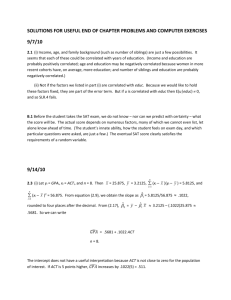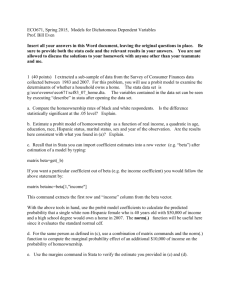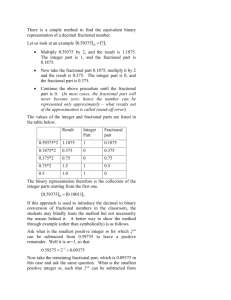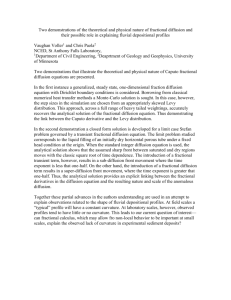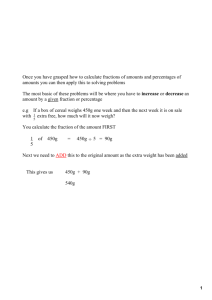Analyzing Proportions - University of Notre Dame
advertisement
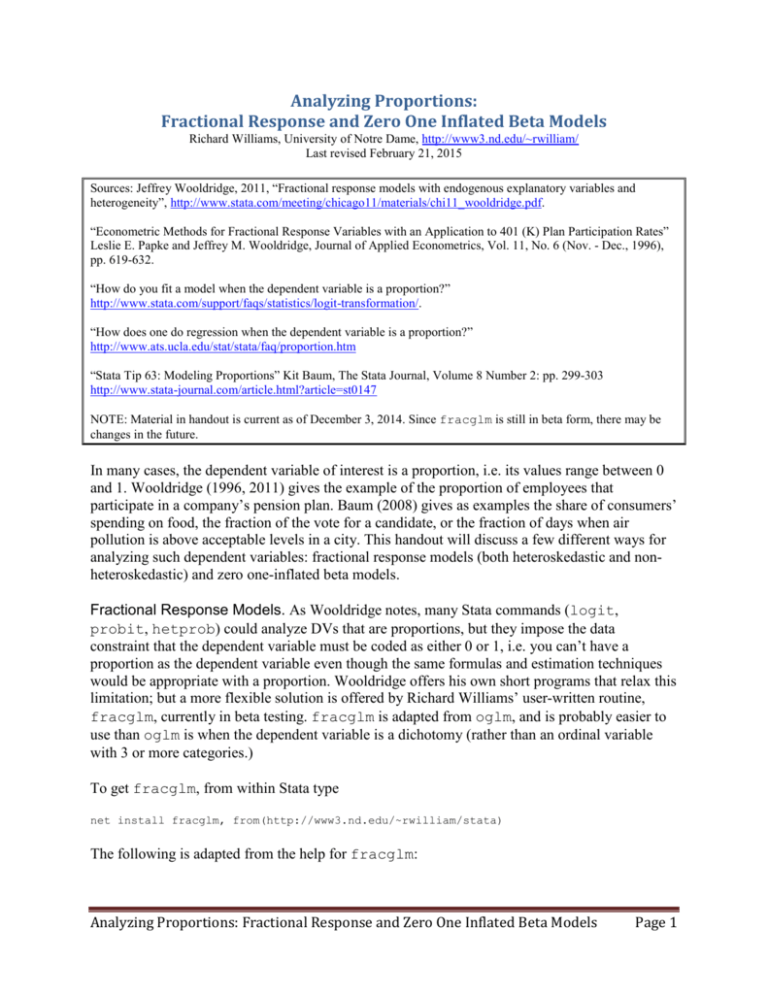
Analyzing Proportions: Fractional Response and Zero One Inflated Beta Models Richard Williams, University of Notre Dame, http://www3.nd.edu/~rwilliam/ Last revised February 21, 2015 Sources: Jeffrey Wooldridge, 2011, “Fractional response models with endogenous explanatory variables and heterogeneity”, http://www.stata.com/meeting/chicago11/materials/chi11_wooldridge.pdf. “Econometric Methods for Fractional Response Variables with an Application to 401 (K) Plan Participation Rates” Leslie E. Papke and Jeffrey M. Wooldridge, Journal of Applied Econometrics, Vol. 11, No. 6 (Nov. - Dec., 1996), pp. 619-632. “How do you fit a model when the dependent variable is a proportion?” http://www.stata.com/support/faqs/statistics/logit-transformation/. “How does one do regression when the dependent variable is a proportion?” http://www.ats.ucla.edu/stat/stata/faq/proportion.htm “Stata Tip 63: Modeling Proportions” Kit Baum, The Stata Journal, Volume 8 Number 2: pp. 299-303 http://www.stata-journal.com/article.html?article=st0147 NOTE: Material in handout is current as of December 3, 2014. Since fracglm is still in beta form, there may be changes in the future. In many cases, the dependent variable of interest is a proportion, i.e. its values range between 0 and 1. Wooldridge (1996, 2011) gives the example of the proportion of employees that participate in a company’s pension plan. Baum (2008) gives as examples the share of consumers’ spending on food, the fraction of the vote for a candidate, or the fraction of days when air pollution is above acceptable levels in a city. This handout will discuss a few different ways for analyzing such dependent variables: fractional response models (both heteroskedastic and nonheteroskedastic) and zero one-inflated beta models. Fractional Response Models. As Wooldridge notes, many Stata commands (logit, probit, hetprob) could analyze DVs that are proportions, but they impose the data constraint that the dependent variable must be coded as either 0 or 1, i.e. you can’t have a proportion as the dependent variable even though the same formulas and estimation techniques would be appropriate with a proportion. Wooldridge offers his own short programs that relax this limitation; but a more flexible solution is offered by Richard Williams’ user-written routine, fracglm, currently in beta testing. fracglm is adapted from oglm, and is probably easier to use than oglm is when the dependent variable is a dichotomy (rather than an ordinal variable with 3 or more categories.) To get fracglm, from within Stata type net install fracglm, from(http://www3.nd.edu/~rwilliam/stata) The following is adapted from the help for fracglm: Analyzing Proportions: Fractional Response and Zero One Inflated Beta Models Page 1 fracglm estimates Fractional Response Generalized Linear Models (e.g. Fractional Probit, Fractional Logit) with or without heteroskedasticity. Fractional response variables range in value between 0 and 1. An example of a fractional response variable would be the percentage of employees covered by an employer's pension plan. fracglm also works with binary 0/1 dependent variables. fracglm supports multiple link functions, including logit (the default), probit, complementary log-log, log-log, log and cauchit. When these models include equations for heteroskedasticity they are also known as heterogeneous choice/ location-scale / heteroskedastic regression models. fracglm fills gaps left by other Stata commands. Commands like logit, probit and hetprob do not allow for fractional response variables. glm can estimate some fractional response models but does not allow an equation for heteroskedasticity. Several special cases of generalized linear models can also be estimated by fracglm, including the binomial generalized linear models of logit, probit and cloglog (which also assume homoskedasticity), hetprob, as well as similar models that are not otherwise estimated by Stata. This makes fracglm particularly useful for testing whether constraints on a model (e.g. homoskedastic errors) are justified, or for determining whether one link function is more appropriate for the data than are others. Example. Papke and Wooldridge (1996) give an example of participation rates in employer 401(k) pension plans. “Pension plan administrators are required to file Form 5500 annually with the Internal Revenue Service, describing participation and contribution behavior for each plan offered. Papke (1995) uses the plan level data to study, among other things, the relationship between the participation rate and various plan characteristics, including the rate at which a firm matches employee contributions.” In Wooldridge’s (2011) version of this example, data are from 4,075 companies in 1987. The key variables used in this analysis are: . use http://www3.nd.edu/~rwilliam/statafiles/401kpart, clear . codebook prate mrate ltotemp age sole, compact Variable Obs Unique Mean Min Max Label -------------------------------------------------------------------------------------prate 4075 2597 .840607 .0036364 1 partic/employ mrate 4075 3521 .463519 0 2 plan match rate, per $ ltotemp 4075 2147 6.97439 4.65396 13.00142 log(totemp) age 4075 50 8.186503 1 71 age of the plan sole 4075 2 .3693252 0 1 =1 if only pension plan -------------------------------------------------------------------------------------- Wooldridge (2011) gives an example of a fractional probit model with heteroskedasticity. He recommends using robust standard errors (otherwise the standard errors are too large; you can confirm this by rerunning the following example without vce(robust); you will see dramatic differences in the test statistics and standard errors. vce(robust) is not required when the dependent variable is a 0/1 dichotomy)). He wrote his own program for this but fracglm can easily reproduce his results. Analyzing Proportions: Fractional Response and Zero One Inflated Beta Models Page 2 . fracglm prate mrate ltotemp age i.sole, het(mrate ltotemp age i.sole) vce(robust) link(p) Heteroskedastic Fractional Probit Regression Log pseudolikelihood = -1674.5212 Number of obs Wald chi2(4) Prob > chi2 Pseudo R2 = = = = 4075 152.29 0.0000 0.0632 -----------------------------------------------------------------------------| Robust prate | Coef. Std. Err. z P>|z| [95% Conf. Interval] -------------+---------------------------------------------------------------prate | mrate | 1.384694 .223861 6.19 0.000 .9459349 1.823454 ltotemp | -.1495096 .013966 -10.71 0.000 -.1768825 -.1221367 age | .0670722 .0100639 6.66 0.000 .0473474 .086797 1.sole | -.11827 .0932336 -1.27 0.205 -.3010046 .0644645 _cons | 1.679377 .1058994 15.86 0.000 1.471818 1.886936 -------------+---------------------------------------------------------------lnsigma | mrate | .240357 .0537812 4.47 0.000 .1349479 .3457662 ltotemp | .0375185 .0144217 2.60 0.009 .0092525 .0657845 age | .0171714 .0027289 6.29 0.000 .0118229 .0225199 1.sole | -.1627546 .0631069 -2.58 0.010 -.2864417 -.0390674 ------------------------------------------------------------------------------ Wooldridge (2011) notes that a simple Wald test can be used to determine whether the coefficients in the heteroskedasticity equation are significantly different from zero. (I believe this is better than a likelihood ratio test because LR tests are problematic when using robust standard errors). . test [lnsigma] ( ( ( ( ( 1) 2) 3) 4) 5) [lnsigma]mrate = 0 [lnsigma]ltotemp = 0 [lnsigma]age = 0 [lnsigma]0b.sole = 0 [lnsigma]1.sole = 0 Constraint 4 dropped chi2( 4) = Prob > chi2 = 109.26 0.0000 You interpret these results pretty much the same way you would interpret the results from a hetprobit model. A higher match rate, an older fund, and having fewer employees all increase participation rates. If you want to make results more tangible, you can use methods like we have used before. For example, Analyzing Proportions: Fractional Response and Zero One Inflated Beta Models Page 3 . margins , dydx(*) Average marginal effects Model VCE : Robust Number of obs = 4075 Expression : Pr(prate), predict() dy/dx w.r.t. : mrate ltotemp age 1.sole -----------------------------------------------------------------------------| Delta-method | dy/dx Std. Err. z P>|z| [95% Conf. Interval] -------------+---------------------------------------------------------------mrate | .159632 .0114214 13.98 0.000 .1372466 .1820175 ltotemp | -.0306262 .0020032 -15.29 0.000 -.0345524 -.0267 age | .0065659 .0006323 10.38 0.000 .0053266 .0078052 1.sole | .016089 .0061307 2.62 0.009 .0040729 .028105 -----------------------------------------------------------------------------Note: dy/dx for factor levels is the discrete change from the base level. .75 .8 Pr(prate), predict() .85 .9 .95 . mcp mrate, at1(0 (.05) 2) 0 .5 1 mrate 1.5 2 Wooldridge (2011) also says you “should do a comparison of average partial effects [aka average marginal effects] between ordinary fractional probit and heteroskedastic fractional probit.” Nonheteroskedastic models can also be estimated with fracglm: . fracglm prate mrate ltotemp age i.sole, vce(robust) link(p) Fractional Probit Regression Log pseudolikelihood = -1681.9607 Number of obs Wald chi2(4) Prob > chi2 Pseudo R2 = = = = 4075 695.89 0.0000 0.0591 -----------------------------------------------------------------------------| Robust prate | Coef. Std. Err. z P>|z| [95% Conf. Interval] -------------+---------------------------------------------------------------mrate | .5955726 .038756 15.37 0.000 .5196123 .6715329 ltotemp | -.1172851 .0080003 -14.66 0.000 -.1329655 -.1016048 age | .0180259 .0014218 12.68 0.000 .0152392 .0208126 1.sole | .0944158 .0271696 3.48 0.001 .0411645 .1476672 _cons | 1.428854 .0593694 24.07 0.000 1.312493 1.545216 ------------------------------------------------------------------------------ Analyzing Proportions: Fractional Response and Zero One Inflated Beta Models Page 4 . margins, dydx(*) Average marginal effects Model VCE : Robust Number of obs = 4075 Expression : Pr(prate), predict() dy/dx w.r.t. : mrate ltotemp age 1.sole -----------------------------------------------------------------------------| Delta-method | dy/dx Std. Err. z P>|z| [95% Conf. Interval] -------------+---------------------------------------------------------------mrate | .1362769 .0088064 15.47 0.000 .1190167 .1535372 ltotemp | -.0268368 .0018454 -14.54 0.000 -.0304537 -.0232199 age | .0041246 .0003277 12.59 0.000 .0034824 .0047669 1.sole | .0213349 .0060421 3.53 0.000 .0094927 .0331771 -----------------------------------------------------------------------------Note: dy/dx for factor levels is the discrete change from the base level. Based on the earlier Wald test we would prefer the heteroskedastic model. You can also see that there are some modest differences in the Average Marginal Effects estimated by the two models. Other Comments on Fractional Response Models: 1. Other than the fact that the heteroskedastic model fits better in this case, what is the rationale for it? I asked Jeffrey Wooldridge about this and he emailed me the following: I think of it [the heteroskedastic model] mainly as a simple way to get a more flexible functional form. But this can also be derived from a model where, say, y(i) is the fraction of successes out of n(i) Bernoulli trials, where each binary outcome, say w(i,j), follows a heteroskedastic probit. Then E(y(i)|x(i)) would have the form estimated by your Stata command. Or, we could start with an omitted variable formulation: E[y(i)|x(i),c(i)] = PHI[x(i)*b + c(i)], where the omitted variable c(i) is distributed as Normal with mean zero and variance h(x(i)). As an approximation, we might use an exponential function for 1 + h(x(i)), and then that gives the model, too. 2. As noted in Wooldridge (2011) and in the Stata FAQ cited above, the glm command can also be used to estimate non-heteroskedastic models. Specify family(binomial) and either link(p) or link(l). These are the same results that fracglm gave for the non-heteroskedastic model. . glm prate mrate ltotemp age i.sole, vce(robust) link(p) family(binomial) nolog note: prate has noninteger values Generalized linear models Optimization : ML Deviance Pearson = = 885.9205448 896.7484978 No. of obs Residual df Scale parameter (1/df) Deviance (1/df) Pearson Variance function: V(u) = u*(1-u/1) Link function : g(u) = invnorm(u) [Binomial] [Probit] Log pseudolikelihood = -1289.354251 AIC BIC = = = = = 4075 4070 1 .2176709 .2203313 = .6352659 = -32946.47 Analyzing Proportions: Fractional Response and Zero One Inflated Beta Models Page 5 -----------------------------------------------------------------------------| Robust prate | Coef. Std. Err. z P>|z| [95% Conf. Interval] -------------+---------------------------------------------------------------mrate | .5955726 .038756 15.37 0.000 .5196123 .6715329 ltotemp | -.1172851 .0080003 -14.66 0.000 -.1329655 -.1016048 age | .0180259 .0014218 12.68 0.000 .0152392 .0208126 1.sole | .0944158 .0271696 3.48 0.001 .0411645 .1476672 _cons | 1.428854 .0593694 24.07 0.000 1.312493 1.545216 ------------------------------------------------------------------------------ Zero Inflated Beta Models. The Stata FAQ (http://www.stata.com/support/faqs/statistics/logittransformation/) warns that other types of models may be advisable depending on why the 0s or 1s exist. From the FAQ (it talks about a logit transformation but the same is true for probit): A traditional solution to this problem [the dependent variable is a proportion] is to perform a logit transformation on the data. Suppose that your dependent variable is called y and your independent variables are called X. Then, one assumes that the model that describes y is y = invlogit(XB) If one then performs the logit transformation, the result is ln( y / (1 - y) ) = XB We have now mapped the original variable, which was bounded by 0 and 1, to the real line. One can now fit this model using OLS or WLS, for example by using regress. Of course, one cannot perform the transformation on observations where the dependent variable is zero or one; the result will be a missing value, and that observation would subsequently be dropped from the estimation sample. A better alternative is to estimate using glm with family(binomial), link(logit), and robust; this is the method proposed by Papke and Wooldridge (1996). In either case, there may well be a substantive issue of interpretation. Let us focus on interpreting zeros: the same kind of issue may well arise for ones. Suppose the y variable is proportion of days workers spend off sick. There are two extreme possibilities. The first extreme is that all observed zeros are in effect sampling zeros: each worker has some nonzero probability of being off sick, and it is merely that some workers were not, in fact, off sick in our sample period. Here, we would often want to include the observed zeros in our analysis and the glm route is attractive. The second extreme is that some or possibly all observed zeros must be considered as structural zeros: these workers will not ever report sick, because of robust health and exemplary dedication. These are extremes, and intermediate cases are also common. In practice, it is often helpful to look at the frequency distribution: a marked spike at zero or one may well raise doubt about a single model fitted to all data. A second example might be data on trading links between countries. Suppose the y variable is proportion of imports from a certain country. Here a zero might be structural if two countries never trade, say on political or cultural grounds. A model that fits over both the zeros and the nonzeros might not be advisable, so that a different kind of model should be considered. Analyzing Proportions: Fractional Response and Zero One Inflated Beta Models Page 6 Baum (2008) elaborates on the problem of structural zeros and 1s. He notes “the managers of a city that spends none of its resources on preschool enrichment programs have made a discrete choice. A hospital with zero heart transplants may be a facility whose managers have chosen not to offer certain advanced services. In this context, the glm approach, while properly handling both zeros and ones, does not allow for an alternative model of behavior generating the limit values.” He suggests alternatives such as the “zero-inflated beta” model, which allows for zero values (but not unit values) in the proportion and for separate variables influencing the zero and nonzero values (i.e. something similar to the zero-inflated or hurdle models that you have for count data). A one-inflated beta model allows for separate variables influencing the one and non-one values Both the zero and one inflated beta models can be estimated via Maarten Buis’s zoib program, available from SSC. The help file for zoib says zoib fits by maximum likelihood a zero one inflated beta distribution to a distribution of a variable depvar. depvar ranges between 0 and 1: for example, it may be a proportion. It will estimate the probabilities of having the value 0 and/or 1 as separate processes. The logic is that we can often think of proportions of 0 or 1 as being qualitatively different and generated through a different process as the other proportions. Here is how we can apply the one-inflated beta model to the current data. In these data, no company has a value of zero, but about a third of the cases have a value of 1, so we use the oneinflate option to model the 1s separately. . zoib prate mrate ltotemp age i.sole, oneinflate( mrate ltotemp age i.sole) Iteration Iteration Iteration Iteration Iteration 0: 1: 2: 3: 4: log log log log log likelihood likelihood likelihood likelihood likelihood ML fit of oib Log likelihood = -860.34541 = = = = = -1350.3099 -881.01326 -860.4238 -860.34541 -860.34541 Number of obs Wald chi2(4) Prob > chi2 = = = 4075 438.05 0.0000 -----------------------------------------------------------------------------prate | Coef. Std. Err. z P>|z| [95% Conf. Interval] -------------+---------------------------------------------------------------proportion | mrate | .7549614 .0570378 13.24 0.000 .6431693 .8667535 ltotemp | -.1138555 .0111967 -10.17 0.000 -.1358006 -.0919104 age | .0236683 .0022057 10.73 0.000 .0193452 .0279915 1.sole | .0035928 .0397814 0.09 0.928 -.0743772 .0815629 _cons | 1.507286 .0870497 17.32 0.000 1.336672 1.677901 -------------+---------------------------------------------------------------oneinflate | mrate | .9482935 .0859375 11.03 0.000 .7798591 1.116728 ltotemp | -.2918532 .027768 -10.51 0.000 -.3462776 -.2374288 age | .0190046 .0038664 4.92 0.000 .0114266 .0265826 1.sole | .6041419 .0762853 7.92 0.000 .4546255 .7536583 _cons | .4242109 .2017944 2.10 0.036 .0287012 .8197205 -------------+---------------------------------------------------------------ln_phi | _cons | 1.621576 .0262855 61.69 0.000 1.570057 1.673094 ------------------------------------------------------------------------------ Analyzing Proportions: Fractional Response and Zero One Inflated Beta Models Page 7 The one-inflate equation shows that companies with higher match rates, fewer total employees, older plans, and that have only one pension plan available are more likely to have 100% participation in their plans. When participation is not 100%, these same variables (except sole) also are associated with higher participation rates. Other Models & Programs. I am not familiar with these, but the help for zoib suggests that these programs may also sometimes be helpful when modeling proportions: betafit fits by maximum likelihood a two-parameter beta distribution to a distribution of a variable depvar. depvar ranges between 0 and 1: for example, it may be a proportion. dirifit fits by maximum likelihood a Dirichlet distribution to a set of variables depvarlist. Each variable in depvarlist ranges between 0 and 1 and all variables in depvarlist must, for each observation, add up to 1: for example, they may be proportions. fmlogit fits by quasi maximum likelihood a fractional multinomial logit model. Each variable in depvarlist ranges between 0 and 1 and all variables in depvarlist must, for each observation, add up to 1: for example, they may be proportions. It is a multivariate generalization of the fractional logit model proposed by Papke and Wooldridge (1996). For the latter two programs, the help files give as examples models where the dependent variables are the proportions of a municipality’s budget that are spent on governing, public safety, education, recreation, social work, and urban planning. Independent variables include whether or not there are any left-wing parties in city government. If I understand the models correctly, the coefficients tell you how the independent variables increase or decrease the proportion of spending in each area. For example, the results show that when there is no left wing party in city government, less of the city budget tends to get spent on education. Analyzing Proportions: Fractional Response and Zero One Inflated Beta Models Page 8


